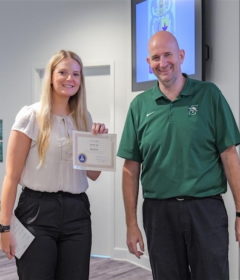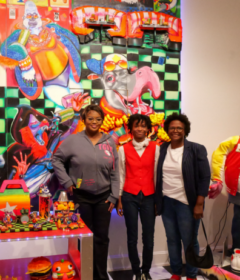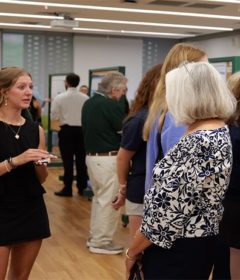Scholar Tells of Those Who Survived the Holocaust in Hiding


In the summer of 1941, as Nazi Germany invaded Western Ukraine, Jewish families began a desperate search for refuge from the mass murders, roundups and deportations to death camps.
Their strategies for survival evolved over time — from running and seeking shelter in the woods to digging bunkers or building elaborate hiding places in their homes — as they grasped the scope of the German genocidal campaign.
Drawing from Jewish diaries, testimonies, memoirs and interviews, renowned Holocaust Studies scholar Natalia Aleksiun, PhD, painted a horrifying and heart-breaking picture of the daily fight for survival endured by Jewish fathers, mothers, children and grandparents.
She presented her talk, “Invisible Jews: Hiding and Passing in Western Ukraine during the Holocaust,” for Stetson’s annual Holocaust Memorial Lecture on April 22. The lecture series began almost 20 years ago and reflects the university’s longstanding commitment to examining the lessons and legacies of the Holocaust.
Aleksiun is the Harry Rich Professor of Holocaust Studies at the University of Florida and author of “Conscious History: Polish Jewish Historians before the Holocaust.” She holds doctoral degrees from Warsaw University in Poland and New York University and has written extensively on the history of Polish Jews, the Holocaust and related topics.
As she explained, the story of Anne Frank has captivated the world. The Jewish girl kept a diary as she and her family lived in hiding in a Secret Annex in Amsterdam. They were discovered after two years and Anne died from the brutal living conditions in Germany’s Bergen-Belsen concentration camp.
But similar stories played out regularly under the Third Reich, not only in [Nazi-occupied] cities, but also in small towns and the countryside like Eastern Galicia (in present day Ukraine).
“Confined to overcrowded hideouts, Jewish men, women and children who had escaped deportations and shootings spent weeks, months, and in some cases, years together. And these are the happy stories,” Aleksiun said. “If they spent two, two and a half years in those hiding places and passing, that in most cases meant that they made it to the arrival of the Russian tanks.”
In these hiding places, Jews faced terror and grief, rationed food, got sick, women got pregnant and gave birth. Survival hinged on help from the Gentiles — whether friends, former co-workers, former customers or patients — who brought them necessary supplies and kept their existence as a secret.
In other cases, however, Gentiles turned on Jewish acquaintances and alerted German authorities to these hiding places or an attempt to pass as a non-Jew. It’s difficult to explain what differentiated the Gentiles who helped Jews from those who betrayed them, Aleksiun added.
“I wish I had the formula,” she said. “There is a huge body of literature that is trying to make sense of what makes people act in a certain way in those situations. I can tell you some of the patterns. I think in the end it’s individual choices.”
The 2025 Holocaust Memorial Lecture was sponsored by Stetson Hillel, the Office of Religious and Spiritual Life, the Program in Jewish Studies, the Program in Russian, East European and Eurasian Studies, the Department of Philosophy, the Department of Religious Studies, the Department of History, the Honors Program, the College of Arts and Sciences, and the School of Music.
– Stetson Today



